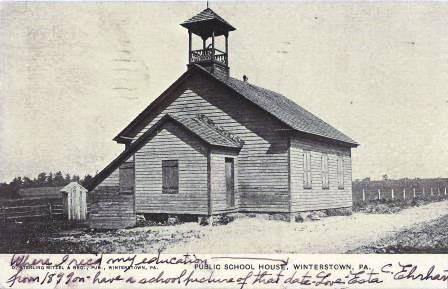
About 1830, Townsend Winters of Steuben County, NY, purchased 400 acres of land for $2,000 from the heirs of Reverend John Smith on which the borough of Winterstown is now built and laid it out into large lots. The land was covered in timber, so he had that cleared and planted a large apple orchard, which led to the town originally being named “Apple Grove”. He then sold the land in large lots.
Winters then began to build a house, but before it was completed he sold it to Daniel Brenneman who resided there and then erected a blacksmith shop on the property. This property was later owned by David Herbst and then by Ralph Rineholt who lived there and operated a garage. Winters then built another house where he lived, this home was later occupied by Henry Landis for over 50 years and then later Marcellus Baughman.
In order to perpetuate his name and legacy, the name of the town was changed from Apple Grove to Winterstown, and this new name was used when the town was surveryed by William Norris and officially became a borough on January 2, 1871 when a charter of incorporation was obtained.
In square miles, Winterstown is one of the largest boroughs in York County. In regards to population, it is one of the smallest. In 1880, only 190 people lived in town, 130 years later in 2010 the population was still only 632 people.
The first store in the village was kept by Emanuel Klinefleter at the southern end of the village, on the corner of Main St. and Hill St. Daniel S. Mitzel owned a store at the northern end of the borough that read: D. S. Mitzel, Dealer in Dry Goods, Groceries, Hardware, Queensware, Notions, Boots, Shoes, Hats and Caps. Guano and Phosphates, Oak Baskets and Country Produce taken in exchange for Goods. Later, the store was taken over by two of his son, D. Sterling and James. Later, it was operated by Ross Anderson, Spencer Mitzel and Howard Grim, Gerald Mitzel and lastly by Delle Hildebrand. It closed in 1968.
The next merchant at the southern end of the borough was E. G. Gemmill, it later became the home of a Mrs. Gembe. The store’s sign read: E. G. Gemmill, Dealer in Dry Goods, Notions, Hardware, Boots, Shoes, Hats and Caps. Manufacturer of fine cigars and Justice of the Peace.
Across from E. G. Gemmill’s store was a hotel operated by G. W. Carman. In addition to the hotel, Carman also was a wholesale dealer in ice cream, which was a rarity in those days. After Carman’s retirement, the hotel was operated by Cornelius Geesey. This home was later occupied by Robert Brown.
Urias S. Snyder and William Graham had a store in the southern end of the borough. The store was destroyed by fire and Graham retired, so Snyder rebuilt the store and operated it by himself. It was later operated by his son True Snyder, then Guy Roseman and later by Mr. & Mrs. Gene Strayer
In the early years, Winterstown had its own post office. Adam Strayer, a veteran of the Civil War, was the first postmaster. He was followed by George Joeckel, a German shoemaker who used part of his shop as the post office. The next postmaster was Urias Snyder, who used his store as the location of the post office. When the Rural Free Delivery system was established for mail delivery, the post office at Winterstown was discontinued.
The first school building was built in the early 1880’s, like most schools of the time it was a one-room schoolhouse and was built where the fire house now stands. In 1911, land was purchased across the street, to build a new school house. This is on property where the North Hopewell Winterstown Elementary School is located today.
- Sources:
- History of the Borough of Winterstown, Winterstown Centennial 1871-1971
- History of York County, Pennsylvania, Volume 1, by George R. Prowell
- History of York County, Pennsylvania. From the Earliest Period to the Present Time, by John Gibson